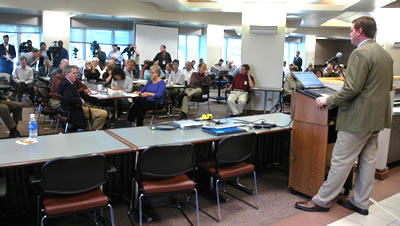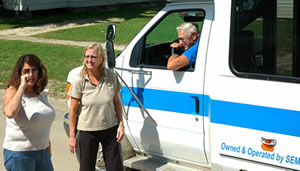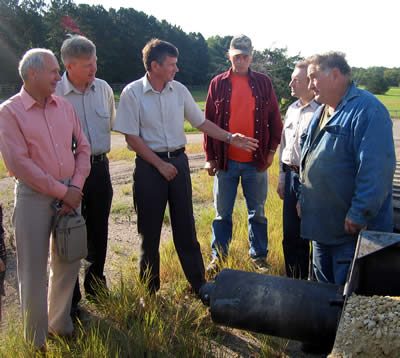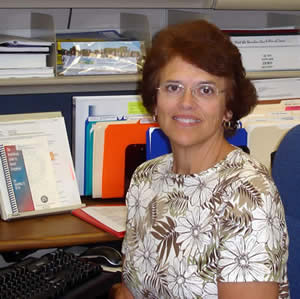 |
|

|
 |
TABLE of CONTENTS
 |
Mn/DOT chooses contractor to replace I-35W bridge in Minneapolis |

Jon Chiglo, project manager, takes a question from the news media at the close of the bid letting held Sept. 19 at the Transportation Building in St. Paul. Photo by Craig Wilkins |
By Craig Wilkins
Mn/DOT officials Sept. 19 opened bids from contractors to replace the collapsed Interstate 35W bridge in Minneapolis.
The apparent winning bid was from the Flatiron-Manson joint-venture contracting team based in Colorado and Seattle.
Flatiron-Manson won the bid by earning the highest number of technical points, 91.47 of 100, during a review conducted by representatives from Mn/DOT, the city of Minneapolis and the Association of General Contractors.
Although the joint venture’s overall cost, $233,763,000, and its construction time, 437 days, were the highest submitted, the state’s design-build, best value formula determined the Flatiron-Manson bid best meets the department’s criteria.
Three other contracting partnerships submitted bids as well.
All of the bids included design criteria to include future use of the bridge by light rail transit.
“We might pay a little more, but when we do that, we feel we get a little better approach,” said Jon Chiglo, project manager.
The Flatiron-Manson bid will get additional review from a project oversight panel in areas such as structural quality, geometric design and aesthetics.
Final approval is expected near the end of this month. Work on the project will begin in mid-October.
Lt. Gov./Commissioner Carol Molnau opened the bid letting praising Mn/DOT, other government agencies and the contractors for their work developing and reviewing the design proposals under intense pressure and scrutiny.
“This is an important day,” she said. “I appreciate your moving forward as fast as you have to make rebuilding this bridge possible.”
|
 |
|

|
 |
TABLE of CONTENTS
 |
Special legislative session yields funding for disaster relief |
By Erik Rudeen, legislative liaison

Hwy 74 near Whitewater State Park in southeast Minnesota was severely damaged in August by flooding. The highway and other projects will benefit from the disaster relief funds appropriated by the Legislature during its one-day special session Sept. 11. Photo by Brad Horn
|
In a one-day special session Sept. 11, the Minnesota Legislature enacted disaster relief legislation that includes $157.3 million for flood relief in southeast Minnesota; $55.2 million for the Interstate 35W bridge collapse, and $5.3 million for other flood, drought and fire aid.
Gov. Tim Pawlenty signed the bill shortly after it was passed.
Flood relief
The newly implemented law provides $157.3 million for flood relief in southeast Minnesota. As a result, $20 million in trunk highway bonds are available for reconstruction and repair of trunk highways and trunk highway bridges damaged by flooding in southeast Minnesota. In addition, $5 million trunk highway fund cash is available to Mn/DOT for infrastructure operations and maintenance related to the flood.
For local governments, $26 million in general obligation bonds are provided for capital costs related to rehabilitation and replacement of local roads and bridges damaged or destroyed by flooding in southeast Minnesota.
Bridge collapse
The legislation also appropriates $53.2 million in federal grants and aids for the I-35W bridge collapse to the commissioner of transportation. Federal money must be appropriated by the state Legislature before it is available for expenditure.
An additional $2 million is appropriated from the general fund to the commissioner of public safety for the state and local match for federal disaster assistance to political subdivisions for the I-35W bridge collapse.
Other relief
Finally, the bill includes $5.3 million for assistance with other recent disasters, such as the Ham Lake forest fire, flooding in Browns Valley and Crookston, and drought relief for farmers.
See also the Minnesota Legislature Web page.
|
 |
|

|
 |
TABLE of CONTENTS
 |
Rochester fast-tracks replacement for bridge lost to flooding |
|
By Craig Wilkins
Craig Falkum arrived at the Hwy 76 bridge site the morning of Aug. 19 just in time to see the last sections of its deck tumble into Money Creek in northwestern Houston County. The usually placid creek had carved a new channel and dug out the bridge’s piers, causing it to fall.
On Sept 12, Falkum, who serves as the District 6 bridge engineer, was back at the site with renewed energy and hope.
The contractor started preliminary work that day on a new bridge that will be completed by mid-November.
Falkum said the effort made to replace the span was extraordinary.
“The Bridge Office designed the bridge and our Design Section designed the approaches,” he said. “We really pushed hard to complete the plans so we could start construction right away.”
The district hired two contractors for the project. One contractor fabricates concrete beams for the structure while the other builds the approaches and the new bridge.
Cost for the new bridge is about $1.2 million.
Falkum said the new, concrete bridge will have the same three-pier design as the previous one but will be about 50 feet longer.
Permits and other administrative procedures were streamlined to get the project moving.
“For example,” Falkum said, “we didn’t have to file any kind of historical impact statement because, well, the bridge is history.”
See also “Intense flash floods devastate roads, bridges in southeastern Minnesota,” (Mn/DOT Newsline, Aug. 22, 2007). |
 |
|

|
 |
TABLE of CONTENTS
 |
Annual study shows traffic congestion worsens nationally |
|
The Texas Transportation Institute this week reported that traffic congestion continues to worsen in American cities of all sizes, creating a $78 billion cost to the U.S. economy in the form of 4.2 billion lost hours and 2.9 billion gallons of wasted fuel. These are among the key findings of the Texas Transportation Institute’s 2007 Urban Mobility Report.
Minneapolis/St. Paul rankings changed little from the previous year — the metro area is ranked 23rd in annual hours of delay per rush-hour traveler, with an average of 43 hours. The national average was 38 hours.
“Congestion continues to grow around the country and Minneapolis/St. Paul is no exception,” said Paul Czech, Metro District Program Management. “We have been able to make improvements in some corridors, such as Interstate 494 in the southwest Metro and I-94 and I-694 Brooklyn Center and Maple Grove, which have provided local benefits.”
The TTI report can be reviewed in full at http://mobility.tamu.edu/.
|
 |
|

|
 |
TABLE of CONTENTS
 |
Transit buses serve crucial role in flood recovery work |
By Craig Wilkins

Jean Meyer (left) confers with Erlene Welshons, SEMCAC transportation director, and driver John Meisch as they established new bus stops in Rushford. Photo by David Gonzalez |
Buses that usually carry people to their destinations were pressed into service in Rushford and other places to serve a much more immediate need—recovery from the floods that ravaged southeastern Minnesota.
Jean Meyer, District 6 transit manager, said the buses carried rescue workers and volunteers and were used to evacuate residents of a nursing home in Houston.
The transit buses also provided a way to transport equipment and supplies to people involved with the flood recovery effort.
Meyer said the response from the Three Rivers and Southeastern Minnesota Community Action Council transit systems was remarkable because many drivers and other employees lost homes or suffered other damage from the floods.
In addition, SEMCAC’s headquarters in Rushford was damaged by the flood. The agency moved its headquarters to Winona until the Rushford facility can be rebuilt.
Drivers had to negotiate through detours, partially washed out roads and traffic to reach their destinations.
“No businesses were open in many areas,” Meyer said, “so the buses provided a way to get supplies, equipment, clothing and meals to the people involved in rescue and recovery work.”
Meyer worked in disaster recovery with the Red Cross for 10 years before joining Mn/DOT in 1999.
“The transit systems relied on their disaster recovery plans and the resilience of their staff to provide essential services during the flooding,” she said.
“Even now, nearly a month later, the clean-up work continues,” Meyer said. “Many people will not have a home for months to come and will rely on the efforts of dedicated volunteers and agencies to help them recover.
“Transit services continue to provide daily services to the many volunteers and community residents throughout the Rushford area,” she said.
|
 |
|

|
 |
TABLE of CONTENTS
 |
Russians, Minnesotans speak the same language on highway needs |
|
By Craig Wilkins

Ken Peterman, a transportation generalist at Cannon Falls (at right) demonstrates the gravel auger he invented. Viewing the demonstration are (from left) Stepan Tyapugin, Anatoliy Vakhrushev and Alexander Petukhov from Mairy El; Terry Hofstad, a transportation generalist at Zumbrota, and Gennadiy Begelman, Mn/DOT. Photo by Craig Wilkins |
In the world of transportation, some things translate very easily.
The quest for funding and ways to deliver services as effectively as possible, for instance.
When Russian visitors toured the Cannon Falls truck station, both issues were communicated by a translator, a Russian-speaking Mn/DOT engineer, and by demonstrations of road maintenance and construction innovations.
The Cannon Falls visit was made by highway officials from the Russian oblast (or state) of Mairy El during their Sept. 10-20 stay in Minnesota. Previous exchange visits were held in 2005. Mn/DOT joined in the FHWA-sponsored exchange program in 2004.
The delegation met the commissioner’s staff, toured the Mn/ROAD project, visited several project sites and exchanged information and expertise with staff and officials throughout the state.
Among the innovations that intrigued the visitors at Cannon Falls was a skid steer-mounted auger that spreads a narrow row of gravel.
Ken Peterman, a transportation generalist who devised the auger, demonstrated how it works for small-scale shoulder repairs and other work normally done by hand.
“The Russians were really impressed by that,” said Tim Zierden, District 6 sub-area supervisor at Red Wing. “They also expressed interest in our weather reporting system and the number of highway miles maintained by small stations such as Cannon Falls.
“I thought they were going to be here for about 15 minutes, but they stayed for two hours,” he said.
Stepan Tyapugin, a deputy director with Mairy El’s Highway Administration, said a major focus of this trip is learning about Mn/DOT’s pavement recycling methods.
Mairy El is about one-half the size of Minnesota and is located in central Russia. The climate is slightly warmer than Minnesota’s.
Mairy El acquired its first recycling equipment in August. The Russians visited sites where the equipment is used to learn first-hand how to maximize its effectiveness.
They also toured Mn/DOT’s Materials Lab in Maplewood to learn how emulsions are used in bituminous paving and new developments in stone mastic asphalt pavement design.
Roger Olson, a research engineer, was part of a Mn/DOT contingent that visited Mairy El in July. He said Mairy El’s highway system needs improvement and can benefit greatly from low-cost methods such as recycling.
Noting the Russians’ growing expertise, Olson said, “They showed us new construction using the stone mastic asphalt design. They used uniform, high-quality aggregate shipped from the Ural Mountains, a key ingredient that comprises 70 to 80 percent of the paving material.”
The Office of Construction and Innovative Contracting’s Gennadiy Begelman served as host, guide and interpreter during the visit.
The Russian-born Begelman came to the United States in 1993. He now serves as a project engineer with Mn/DOT.
“Our visitors learned a great about paving, recycling and other practices,” he said. “They also gained an appreciation of the highway project management system that allows us to accomplish a lot of work in relatively little time at reasonable costs.”
|
 |
|

|
 |
TABLE of CONTENTS
 |
Hurt in bridge collapse: Metro inspector Bob Rucker progresses toward recovery |
By Craig Wilkins
Returning early from a dinner break nearly cost Bob Rucker his life.
Rucker, a Metro District bridge inspector, was just starting to resume work on the Interstate 35W bridge after dinner at a nearby McDonald’s when the structure lurched and collapsed under him.
Rucker’s fellow inspectors were still at dinner when the bridge fell.
“The bridge kind of jerked,” he said. “I knew it was nothing normal.”
Rucker said he took about three strides toward safety when he realized the bridge was going to fall.
The bridge hit with such force that it knocked me out for a few seconds. When I came to, I saw that I was lying under the rear wheel assembly of the concrete truck that fell with the bridge.
- Bob Rucker |
“I knew the deck was going to let loose right away,” he said.
Moments later Rucker dropped 60 feet as he and the bridge crashed into the Mississippi River.
“It was an awful feeling to see the riverbank passing by as we fell,” Rucker said.
“The bridge hit with such force that it knocked me out for a few seconds,” he said. “When I came to, I saw that I was lying under the rear wheel assembly of the concrete truck that fell with the bridge.”
Rucker suffered five broken ribs plus foot, shoulder and elbow injuries.
He was hospitalized for five days for treatment of his injuries. He was readmitted a few days later due to fluid on his lungs that developed during his first hospital stay.
Rucker returned to his Cottage Grove home on Aug. 16 to begin his recovery.
Rucker is most troubled by the death of Greg Jolstad, a contractor’s employee who was working about 30 feet from him when the bridge collapsed.
“Jolly (Jolstad) was a great guy,” he said.
“Emotionally, I have good days and bad days; I know I’m lucky to be alive,” he said.
Rucker says he plans to return to work when he is physically able.
“My plan is to return to my job and then see how I feel about going back to working on bridges,” he said.
|
 |
|

|
 |
TABLE of CONTENTS
 |
Cancer claims life of Red Wing truck station’s Charles Carlson |
Funeral services were held Aug. 29 in Zumbrota for Charles “Charlie” Carlson, a transportation generalist at the Rochester District’s Red Wing truck station.
Carlson, 56, died from complications related to cancer Aug. 26.
“Charlie will be missed,” said Tim Zierden, Carlson’s supervisor at Red Wing. “He was a good guy who never complained and really enjoyed his job.”
Co-worker Terry Schmitt added that Carlson served on the district’s Fall Maintenance Expo and labor-management committees.
“Charlie was always positive and focused on the upside of life,” he said.
Carlson, who joined Mn/DOT in 1997, served on several committees and often worked at the department’s exhibit at the Minnesota State Fair.
Survivors include his wife, Randi Dahling Carlson, his mother and four siblings.
|
 |
|

|
 |
TABLE of CONTENTS
 |
Recent catastrophic events pull employees together |
By Nelrae Succio, District 6 Engineer

"Never in my 25-year career at Mn/DOT would I have imagined such an occurrence happening," Nelrae Succio, District 6 transportation engineer, said of the I-35W bridge collapse over the Mississippi River. Photo by Krystal Ohlhaber |
August 2007 will be a month to remember for Mn/DOT employees.
First, the Interstate 35W bridge collapsed. Never in my 25-year career at Mn/DOT would I have imagined such an occurrence happening. Our employees rallied to the cause and three of our District 6 employees (Paul Bissen, Jim Duff and Terry Ward) were sent to help out with the demolition and rebuilding efforts.
Then our own disaster hit–the Aug. 18-19 flooding in southeast Minnesota. While the rains came, the seemingly tranquil brooks and creeks became raging rivers. One employee mentioned that she used to hop across the exposed rocks in the Garvin Brook near Minnesota City. Now, the old Hwy 61 bridge over this brook is gone and the innocent brook is 50-75 feet wide.
In addition, District 6 employees Darrin Aarre (Stockton), Wayne Hasleiet and Duane Himlie (Rushford residents) and their families were affected by the storms. Employees aided them in their time of need and I hope this eased some of their tremendous burden when facing the loss of personal possessions and possibly their homes.
As I've visited with numerous employees, I've learned that many of our maintenance folks helped with rescue efforts, which no doubt saved lives. We have many unsung heroes in our midst. Greg Husmann (Dresbach subarea supervisor) assisted an elderly couple whose house slid from its foundation and nearly buried the husband alive (see article below). Several others literally plucked people out of the raging waters.
Throughout several counties in District 6, our roads and infrastructure were significantly impacted–causing tremendous damage and safety issues. Gov. Pawlenty declared a state of emergency for Winona, Wabasha, Fillmore, Houston, Steele and Olmsted counties. President Bush declared several counties federal disaster areas.
We have a lot of work to do before Nov. 1 – our official date for snow and ice season – which I am confident we can accomplish through our own efforts and through the offers of assistance (both equipment and personnel) from other districts and the support from state and federal agencies.
We had to close a number of highways; some are still closed and others have opened. Emergency contracts are in place to rebuild highways, bridges and fix numerous maintenance issues. Dave Redig, Wes Smith and the maintenance crews have worked around the clock to clear debris and keep the roadways safe. Crews from all over the district were hauling nearly 1,000 yards of materials away each day. Bridge crews have looked for creative ways to get to debris trapped under our bridges and remove it.
Our design folks worked with the CO bridge office and numerous other offices on two emergency design contracts. We lost the bridge just north of Money Creek on Hwy 76 and a portion of the road on Hwy 74 (Whitewater State Park), so we are in the process of rebuilding these areas. We’ve currently identified more than 300 repair sites; with each additional rain, these sites grow.
Teamwork is essential as we work through this situation.
I can't begin to say how proud I am of our district employees and department as a whole. We have truly come together in this time of emergency and crisis. The exceptional help from our co-workers throughout the agency has been tremendous and I want to thank each of you for your support, thoughts and prayers.
Maintenance folks help with rescue efforts
Greg Husmann has the knack, it seems, of being in the right place at the right time.
He serves as maintenance supervisor for District 6’s La Crescent subarea.
When floods hit on Aug. 18, Husmann got an early morning call to clear a path through a mud- and rubble-covered county road for a State Patrol officer responding to help an elderly couple who had spent the night trapped in the ruins of their home near Hokah.
A mudslide had destroyed their home.
When Husmann and Officer Carl Ukkestad arrived about 7 a.m., they found the husband buried in mud and his wife clinging to what little remained of their house. Their son had arrived a few minutes before.
“At first, we thought he was dead because his body was so cold,” Husmann said. “His eyes were fastened shut from the mud, but he moved and we realized he was alive.”
Husmann recognized the man as Harold Zibrowski, 83, a World War II veteran and a member of his Veterans of Foreign Wars post in La Crescent.
Phyllis Zibrowski called out to her husband every 15 minutes through the night to keep him from losing consciousness.
Husmann and Ukkestad held Zibrowski’s head to help him breathe. Then they wrapped him in rugs to help him regain some heat in his body and stayed with the couple until an ambulance arrived.
Zibrowski was released from the hospital a few days later.
“I’ve seen a lot of destruction in my life but this experience really rocked me back in my socks," Husmann said. “The question now is how are we going to fix all of this stuff?”
|
|
 |
|
| |
|



